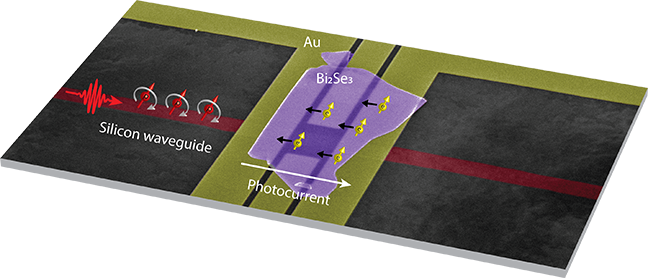By Warren Miller, contributing writer
When you hear the phrase “spinning light,” you probably think of a particularly unpleasant evening. Researchers at the University of Minnesota (UM) have other thoughts on the matter, as they’re using “spinning light” to control the flow of electric current.
Before now, changing the direction that an electrical current flowed required an electric voltage, but the UM team has discovered a way to manipulate generated electric current, or photocurrent, by changing which direction the particles within the current are spinning. Those particles, called photons, are polarized, similar to the way electrons are polarized.
Researchers recently discovered that materials called topological insulators, or TIs, have the property of causing electrons all spinning in the same direction to flow in the same direction as well. When shining a circularly polarized light (as opposed to a light polarized in a straight line) on the surface of a TI, the electrons contained therein break free and flow either clockwise or counterclockwise, depending on whether they’re spinning up or down. Shining a photocurrent on the surface of a TI has the same effect — the photons all head in one direction or the other, depending on the direction they’re spinning in, without the need for an electric voltage to tell them which way to go. By integrating a thin film of TI bismuth selenide onto a silicon optical waveguide, the researchers created a device that makes the light flowing through the waveguide and the electric current moving over the surface of the TI material flow and spin in the same direction. Reversing the direction of the light reverses both the direction of the current and the current’s spin polarization.

This shows a false-colored electron microscope image of the University of Minnesota device. The blue area marks the topological insulator on top of the optical waveguide in red. Image source: University of Minnesota.
“The observed effect is very strong and robust in our devices, even at room temperature and in open air,” said Mo Li, a University of Minnesota electrical and computer engineering associate professor and a lead author of the study. “Therefore, the device we demonstrate has great potential for being implemented in next-generation computation and communication systems.”
The researchers believe that this new technology could have applications in microelectronics (like cellphones) as well as in large-scale optical communication. “Our research bridges two important fields of nanotechnology: spintronics and nanophotonics,” said Li. “It is fully integrated with a silicon photonic circuit that can be manufactured on a large scale and has already been widely used in optical communication in data centers.”
If this technology can create the equivalent of optical transistors, by modulating light flow via a “spin switch,” the promise of super-fast and extremely low-power optical computers may just be that much closer. If decades worth of transistor-based computer architecture can be leveraged with switches based on spin technology, optical computing could be just a few years away, not the decades it would be if everything needed to be recreated from the ground floor. Now we just need to think about what we would do if we entered another golden age when orders of magnitude improvements in computing power, lower cost, and lower power were available every couple of years.
Advertisement
Learn more about Electronic Products Magazine





